Upper Valdarno
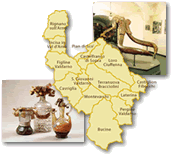
Situated between the mountains of Pratomagno and the Chianti hills, in an ideal triangle formed by three capital cities of provinces, Florence-Arezzo-Siena, the Upper Valdarno has always distinguished itself for the wealth of its agricultural and handicrafts products. As of the Middle Ages, this portion of the valley was concerned by the birth of numerous planned settlements known as "Terre nuove" (New Lands). Still today, these rigid town-planning criteria dictate the rule to the principal centres of the area: Terranova Bracciolini, San Giovanni Valdarno and Castelfranco di Sopra.
Exiting the Autostrada del Sole (A1) at Incisa, and proceeding for about ten kilometres on SR69/SS69, we reach the ancient village of Figline. Well worth visiting here is the Antica Spezieria dello Spedale Serristori which conserves an interesting collection of historical instruments and officinal containers.
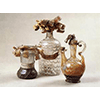
The Serristori Hospital was founded in 1399 by one of the priors of the Republic of Florence, Serristoro di Ser Jacopo. The charity organisation was gradually transformed from a lodging place for pilgrims into a true hospital. The pharmacy seems to have been opened on its premises in the early 16th century. In 1724 it underwent remodelling; dating from this time are the walnut cabinets of Florentine manufacture with which it is furnished. In 1856, with the suppression of the religious congregations in Tuscany, the pharmacy's activity came to an end. Today the collection is managed by the Cultural Department of the Commune of Figline Valdarno.
The collection, made up of glassware and majolica, represents one of the finest examples of Tuscan ceramics and glassware craftsmanship from the late 16th to the 19th century. Of special interest is a set of large vases with manufactured in Montelupo Fiorentino, bearing the Dominican coat of arms and the date 1620, along with some albarellos marked with the heraldic emblem of the Serristori family, dating from the 18th century and commissioned expressly for the Hospital's pharmacy. The collection is completed by mortars, funnels, alembics and numerous glass objects for medicinal herbs.
(Antonella Gozzoli)
Continuing southwest on Via del Cesto, after about 6 km, we come to the locality of Gaville, where the century-old history of the territory’s settlement is described in the local Museo della Civiltą Contadina.
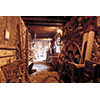
Opened to the public in 1974 and situated in the monumental building complex of the Pieve di San Romolo at Gaville (12th-13th century), the Museum displays over 5,000 objects and tools recording rural life in the Lower Valdarno area, with special attention to the harvesting of grain and the production of olive oil and wine. One of the objects displayed is an olive-oil mill from 1729 driven by animal power, perfectly preserved. The Museum also possesses an interesting herbarium with samples of local medicinal herbs.
In 2000, the Associazione Culturale "Museo della Civiltą Contadina di Gaville" ["Museum of Peasant Civilisation at Gaville Cultural Association] was founded. Its members offer their services as volunteers to run the Museum.
(Anna Toscano)
The next leg of the itinerary is Cavriglia, accessible by travelling SP14 for 20 km, where lovers of botany will not neglect to stop at the Roseto Botanico "Carla Fineschi", one of its kind, which boasts more than 7000 species of roses.
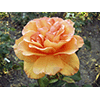
The Cavriglia Rose-garden was born in the second half of the 20th century from the passion of professor Gianfranco Fineschi and his companion Carla Fineschi to whom the garden is dedicated. It contains some 7000 species of roses, several of which were believed to be extinct. Its layout follows the traditional botanical organisation with plants in precise locations and subdivided into sections, species, subspecies and hybrids. Each plant is identified by a card with its botanical name, year of introduction into Europe, and other important identifying data.
One of the most variegated collections of roses, including several rare species, the Cavriglia Rose-garden is used for scientific study and presents the typical features of a botanical laboratory, conducting its own research activity, as well as in collaboration with universities and institutes from the world over.
(Graziano Magrini)
The Cavriglia area is also home to another interesting museum institution, the Centro di Documentazione delle Miniere di Lignite, which preserves record of the area’s old mining tradition.
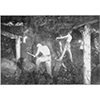
The purpose of the Lignite Mines Documentation Centre is to illustrate the activities in the mines of Castelnuovo dei Sabbioni which have by now exhausted their deposits. The Museum sections exhibit several minerals, including a large block of lignite, and the instruments and materials necessary for mining. The Museum also has a library, an archive and a photographic library.
(Graziano Magrini)
To conclude the itinerary, take SP408 to Montevarchi, which boasts the oldest and most famous museum institution of this territory. The Museo Paleontologico dell'Accademia Valdarnese del Poggio indeed conserves a very important collection of fossils found in the valley since the 15th century.
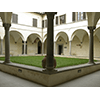
Established in 1804, the Accademia Valdarnese owes its name and its origin to Poggio Bracciolini, the famous humanist, discoverer of manuscripts and collector of antiquities, who, starting in 1434, surrounded himself with scholars and men of letters with whom he engaged in learned conversation. To this band of humanists he gave the name "Accademia Valdarnina". The permanent seat of the meetings was the Villa di Terranova, owned by Bracciolini.
In 1858 the society, on which was conferred the title "Imperiale e Regia Accademia" by Grand Duke Leopold II of Lorraine in 1848, found permanent quarters at the former Monastery of San Ludovico in Montevarchi, where it is still located today, along with the Museum, the Library and the Archives. At present, the Academy is active in the field of historical and scientific research, evidence of which may be found in its publications.
The first core of the Museo Paleontologico was the collection donated to the Accademia Valdarnese by the Vallombrosan monk Domenico Luigi Mulinari. The collection consisted of a large group of fossil remains of the hippopotamus, elephant, rhinoceros and mastodon found in the Valdarno area, and a group of fossils of petrified wood, seashells and marine animals coming from the territories of San Leo and Montefeltro.
At present, the Museum possesses around 2,000 pieces from the Varldarno area Pliocene and post-Pliocene ages, arranged in typically nineteenth-century style. The collection includes plant fossils and remains of mammals (elephants in particular), birds, reptiles, freshwater fish and shellfish, dating from a period ranging between three million and 100,000 years ago. These findings come almost exclusively from the lacustrine and fluvial-lacustrine territories of the Upper Valdarno hill country. Of particular interest are the examples of Elephans Meridionalis, Hippopotamus Maior, Histrix Etrusca, Canis Etruscus and Equus Stenonis. The collection also includes a group of rock samples from the Valdarno area.
The Library contains nearly 20,000 volumes, a consistent number of them dealing with the subjects of the Museo Paleontologico. The Archive too is especially interesting. Among the manuscripts, it has a treatise on optics from the 18th century, as well as catalogues and records of donations and purchases.
(Anna Toscano)
****************************
Texts by Elena Fani
English translation by Victor Beard
Last update 16/giu/2011



 = libraries and archives
= libraries and archives  = scientific research centers
= scientific research centers  = memorial places of scientists
= memorial places of scientists = public health places
= public health places = places of science and worship
= places of science and worship = places of technology
= places of technology  = museums and collections
= museums and collections  = villas and gardens of science
= villas and gardens of science



